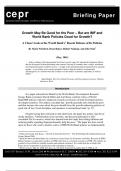ce pr
CENTER FOR ECONOMIC AND P O LICY R ESEAR CH
Br ie fin g Pa pe r
Growth May Be Good for the Poor – But are IMF and
World Bank Policies Good for Growth?
A Closer Look at the World Bank's1 Recent Defense of Its Policies
By Mark Weisbrot, Dean Baker, Robert Naiman, and Gila Neta2
(May, 2001)
"… policy making at the international level has to create space for national development efforts
that are divergent in their philosophy and content. Forcing all countries into a single, neoliberal
developmental model would be unwise – in light of the potential political backlash from national
groups – even if there were serious grounds to believe that the model is economically
advantageous. It is absurd when the evidence on the model's economic superiority is itself in
doubt."
–Dani Rodrik, The New Global Economy and Developing Countries: Making
Openness Work
Introduction
In a paper released last March by the World Bank's Development Research
Group, Bank economists David Dollar and Aart Kraay confront critics of World
Bank/IMF policies with new empirical research on incomes in both developed and less
developed countries. The authors conclude that "growth generally does benefit the poor
and that anyone who cares about the poor should favor the growth-enhancing policies of
good rule of law, fiscal discipline, and openness to international trade."(p. 27)
Despite having been released in only draft form, the paper has gotten a fair bit of
media attention. "Globalisation raises incomes, and the poor participate in full,"
concluded The Economist, which also learned from this study that cutting inflation and
reducing public spending disproportionately help the poor.3 The paper has been seized
upon by those who wish to dismiss critics of IMF/World Bank policies as fundamentally
1
Dollar, David and Aart Kraay , “Growth Is Good for the Poor”. The World Bank Development Research
Group, March 2000.
2
Mark Weisbrot and Dean Baker are co-directors of the Center for Economic and Policy Research (CEPR).
Robert Naiman is senior policy analyst at CEPR. Gila Neta is a research associate at CEPR. The authors are
grateful to Joyce Kim for valuable research and editorial assistance. We would also like to thank Aart
Kraay for his cooperation in sharing data and responding to inquiries.
3
The Economist, May 27, 2000. See also, e.g., the Daily Telegraph (London) June 9, 2000, p. 35.
1015 18 TH STR EET , N .W., SU ITE 200 ! W ASH IN GTO N D .C. 20036 ! 202 293-5380 ! FAX: 202 822-1199
H TTP :// WWW . CEPR . N ET ! EMAIL : CEPR @ CER . N ET
,misguided or worse.4 It is therefore worth taking a closer look at the claims put forth by
the Dollar and Kraay paper and the debate to which it has contributed.
Of course the paper's main finding – that there is generally a positive correlation
between economic growth and the income of the poor – is no surprise. In fact, it is
difficult to imagine who would argue that there were no such correlation.
But the debate joined by Dollar and Kraay misses the most important problem
entirely. Economic growth over the last twenty years, the period during which the
policies advocated by the authors (and their institution) have been put into place, has
been dramatically reduced. It may well be true, as Dr. Dollar argues, that "to ignore the
importance of growth-enhancing policies is an injustice to the poor."5 But to assume that
the World Bank and the IMF have brought "growth-enhancing policies" to their client
countries goes against the overwhelming weight of the evidence over the last two
decades.
Second, the relationship between economic growth and the income of the poor is
not as close as it appears to be from the authors' presentation. The extent to which the
poor – or even the majority of the population – share in the gains from economic growth
can vary considerably over time and as a result of policy changes. As it turns out, there
are plenty of instances in which the poor, and the majority of the population. have been
left behind in the era of globalization – even where per capita income has grown.
Third, the regressions in Dollar and Kraay's research actually show little or
nothing about the relationships between most of the variables examined. Aside from the
correlation between economic growth and the income of the poor, almost all of the other
tests in the paper are statistically insignificant. Given the large errors in the data (see
Appendix B), there is really no conclusion that can be drawn from the failure to find
significant results in these tests. For example, we cannot conclude from these tests that
there are no significant differences in the relation between growth and the income of the
poor between the 1980s and 1990s and previous decades. And there is certainly nothing
in the authors' research to support their conclusion that "globalization is good for the
poor,” (p. 22) or that anti-inflationary policies are "pro-poor."
Finally, the authors' research mirrors what is wrong with the policy of the Bank
and the IMF: the attempt to apply universal economic "laws" – concerning trade, capital
flows, privatization, the size and scope of government – to the problems of economic
development. By any measure of economic performance, the last two decades have
shown these rigid applications of orthodox economic theory to be a failure. Rather than
defending this record of failure, the Bank and Fund researchers should be trying to
discover what has gone wrong. And most importantly, they should allow governments to
pursue their own, country-specific paths to growth and development.
4
See, e.g., Martin Wolf: "Kicking Down Growth's Ladder: Protesters Against the Word Bank and the IMF
are in Effect Seeking to Deny the Poor the Benefits of a Liberal World Economy," Financial Times, April
12, 2000, p. 23.
5
Letter to the Financial Times, June 20, 2000.
2
, Figure 1: Change in Per Capita Income in the Developing World: 1960-1980 vs.
1980-1998
China
Arab States
South Asia
1980-1998
South-East Asia and Pacific
1960-1980
East Asia
Latin America/Caribbean
Sub-Saharan Africa
-50% 0% 50% 100% 150% 200% 250% 300% 350%
Change in Per Capita Income
Source: UNDP Human Development Reports 1998, 2000.
In Figure 1 we can see the rate of growth of GDP per capita for the various
regions of the developing world. If we compare the results since 1980 with the previous
two decades, the difference is striking. In every region except East Asia and South Asia,
the later period shows remarkably slower growth.
In Latin America, for example, GDP per capita grew by 75 percent from 1960-
1980, whereas in the latter period it has only risen 6 percent. For sub-Saharan Africa,
GDP per capita grew by 36 percent in the first period, while it has since fallen by 15
percent.
These are enormous differences by any standard of comparison, and represent the
loss to an entire generation – of hundreds of millions of people – of any chance of
improving its living standards. Even where growth was significant, as in Southeast Asia,
it was still better in the earlier period. The exceptions to this trend were East Asia and
South Asia, which grew faster from 1980 to 1998 than in the previous period. The East
Asian result is due to the quadrupling of GDP, over the latter period, in China (which has
83 percent of the population of East Asia.) The South Asian result is due to faster growth
in India (which has three-quarters of the population of South Asia.)
In short, there is no region of the world that the Bank or Fund can point to as
having succeeded through adopting the policies that they promote – or in many cases,
impose – upon borrowing countries. They are understandably reluctant to claim credit for
3





